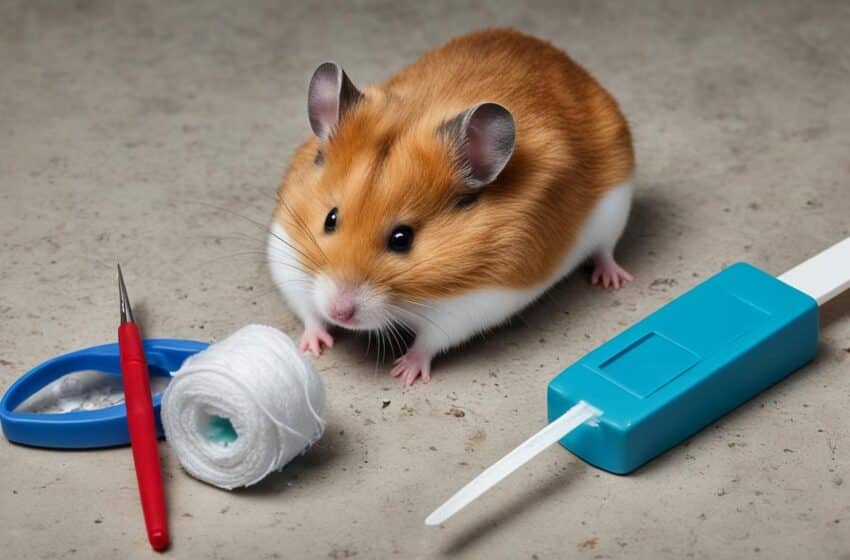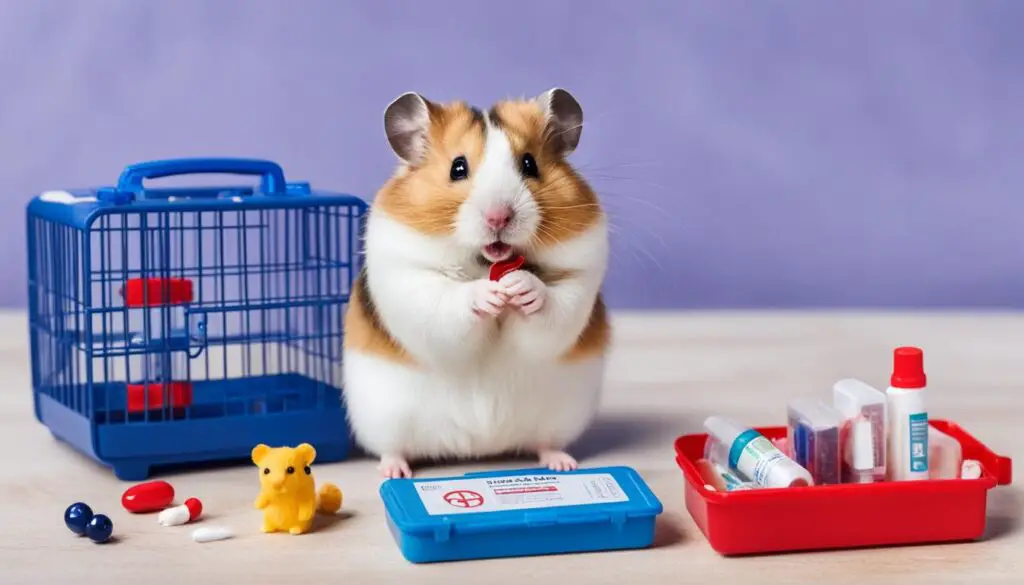Basic First Aid Tips for Hamster Owners

As a responsible hamster owner, it is crucial to be prepared for any potential emergencies. Having basic first aid knowledge can be life-saving for your furry friend. In this section, I will provide you with essential first aid tips that every hamster owner should know. These tips are derived from reliable sources and expert advice to ensure the safety and well-being of your hamster.
Key Takeaways:
- Knowing basic first aid can make a significant difference in your hamster’s well-being.
- Stay calm and act quickly in case of emergencies.
- Wounds, bites, respiratory distress, choking, and dehydration are common first aid situations for hamsters.
- Learn proper techniques for wound cleaning, CPR, the Heimlich maneuver, and rehydration.
- Prevention is key: maintain a safe environment and have a hamster-specific first aid kit ready.
Common First Aid Situations for Hamsters
Hamsters, like any other pets, can experience various health issues or accidents. It is important to know how to handle and provide immediate care for common first aid situations they may encounter.
Some of the most common first aid situations for hamsters include:
- Wounds
- Bites
- Respiratory distress
- Choking
- Dehydration
Each of these situations requires specific first aid measures to ensure the well-being of your hamster. Let’s explore them in detail:
1. Wounds
Wounds can occur due to fights with other hamsters, sharp objects, or accidental falls. It is important to clean the wound and prevent infection. If the wound is severe, seek veterinary assistance.

2. Bites
Hamsters may occasionally bite each other due to territorial disputes or fear. In case of a bite, clean the wound and monitor for signs of infection. If needed, separate the hamsters to prevent further aggression.
3. Respiratory Distress
Respiratory distress can be caused by respiratory infections or irritants in the environment. If your hamster shows signs of labored breathing, sneezing, or wheezing, consult a veterinarian immediately.
4. Choking
Hamsters can choke on small objects or food. If you notice your hamster is choking, gently pat its back to help dislodge the obstruction. If the choking persists, seek veterinary assistance.
5. Dehydration
Dehydration can occur due to insufficient water intake or illness. If your hamster shows signs of dehydration, such as sunken eyes, lethargy, or dry mouth, provide fresh water and consult a veterinarian.
Remember, these are general first aid measures and it is always advisable to consult a veterinarian for professional advice. Taking prompt action and providing appropriate care can greatly improve the chances of a successful recovery for your hamster.
First Aid Techniques for Hamsters
When it comes to providing first aid to your hamster, knowing the right techniques can make a significant difference in their survival and recovery. This section will cover essential first aid techniques that every hamster owner should be familiar with. By following these step-by-step instructions, you can ensure the best possible outcome for your furry friend.
1. Wound Cleaning and Bandaging
Hamsters, like any other pets, can sometimes suffer from wounds due to accidents or fights. It’s crucial to clean and bandage their wounds properly to prevent infections and promote healing. Here’s how you can do it:
- Gently clean the wound with lukewarm water and mild soap.
- Pat the area dry with a clean, sterile gauze or cotton pad.
- Apply an antibacterial ointment to the wound to prevent infections.
- Cover the wound with a sterile non-stick bandage or gauze pad.
- Secure the bandage in place using self-adhesive or paper tape.
Monitor the wound regularly and change the bandage as needed. If the wound doesn’t show signs of improvement or if your hamster seems to be in pain, it’s essential to seek veterinary assistance.
2. CPR for Hamsters
In critical situations such as cardiac arrest, performing CPR (cardiopulmonary resuscitation) on your hamster can potentially save their life. Here are the steps to follow for hamster CPR:
- Place your hamster on a flat and stable surface.
- Check for any obstructions in their airway, and if present, gently clear them.
- Place your index finger and thumb on either side of your hamster’s chest, just behind their front legs.
- Apply gentle pressure and perform five chest compressions.
- Follow it with one to two rescue breaths by gently blowing into their nostrils.
- Repeat the cycle of chest compressions and rescue breaths at a rate of 100-120 compressions per minute.
- Continue until your hamster starts breathing or you can seek veterinary assistance.
Note: CPR should only be performed if you’re trained in the technique or under the guidance of a veterinarian.
3. Heimlich Maneuver for Choking
If your hamster is choking and unable to breathe, the Heimlich maneuver can help dislodge the obstruction from their airway. Here’s how to perform the Heimlich maneuver on a hamster:
- Hold your hamster securely but gently, ensuring their head is facing downward.
- Support their chest with one hand and use the thumb and forefinger of your other hand to apply gentle pressure just below their ribcage.
- Quickly compress the chest area with gentle upward pressure, simulating a cough reflex.
- Repeat the motion up to three times, carefully monitoring your hamster’s response.
- Seek veterinary assistance if the obstruction doesn’t dislodge or if your hamster shows signs of distress.
4. Rehydration Methods
Dehydration can be life-threatening for hamsters. To rehydrate your hamster, you can try the following methods:
- Offer small amounts of water using a dropper or syringe if your hamster is conscious and able to swallow.
- Gently moisten their lips and mouth with water to encourage them to lick the moisture.
- Provide hydrating foods such as watermelon, cucumber, or wet lettuce leaves.
- If your hamster’s condition doesn’t improve, consult with a veterinarian for proper rehydration methods.
Being prepared and knowing these first aid techniques can make a significant difference in your hamster’s well-being during emergencies. Remember, always prioritize the safety and health of your furry friend.
Preventive Measures and Preparedness
While knowing first aid techniques is essential, taking preventive measures and being prepared for emergencies can greatly reduce the chances of your hamster needing immediate medical attention. By implementing these preventive measures and being proactive in your preparedness, you can ensure the overall health and well-being of your furry friend.
Providing a Safe and Hygienic Environment
To prevent accidents and health issues, it is crucial to create a safe and hygienic environment for your hamster. Here are some essential preventive measures:
- Ensure the hamster’s enclosure is free from sharp edges, small gaps, and potential hazards.
- Regularly clean and disinfect the enclosure to maintain proper hygiene.
- Provide suitable toys and accessories that are safe for your hamster to play with.
Regular Health Check-ups
Regular health check-ups are an important part of preventive care for your hamster. A knowledgeable veterinarian can detect any early signs of illness or potential health issues. Schedule regular visits to ensure your hamster’s well-being. During these check-ups, the veterinarian may:
- Examine your hamster’s overall health and behavior.
- Check for any signs of infections, parasites, or abnormalities.
- Provide guidance on diet, exercise, and general care.
First Aid Kit Preparation
Being prepared with a well-stocked first aid kit is crucial in case of emergencies. Your hamster’s first aid kit should contain:
- Gauze pads and bandages for dressing wounds.
- Antiseptic solution for wound cleaning.
- Scissors, tweezers, and gloves for safe handling.
- Oral electrolyte solution for rehydration.
Remember to periodically check and replenish the contents of your hamster’s first aid kit to ensure its readiness when needed.

By implementing these preventive measures and being prepared with a well-equipped first aid kit, you can significantly minimize the risks to your hamster and provide timely care in case of emergencies. Taking these steps will give you peace of mind and help keep your furry friend safe and healthy.
Conclusion
In conclusion, as a responsible hamster owner, acquiring basic first aid knowledge is crucial for ensuring the well-being of your furry companion. By familiarizing yourself with the tips and techniques outlined in this article, you can provide immediate care and potentially save your hamster’s life in case of emergencies.
Remember, prevention is always better than cure. Taking proactive measures, such as maintaining a safe and hygienic environment, scheduling regular health check-ups, and having a well-stocked first aid kit, can minimize the likelihood of accidents or health issues.
By being prepared and knowledgeable, you can effectively address common first aid situations for hamsters, including wounds, bites, choking, and dehydration. Administering proper first aid techniques, such as wound cleaning, CPR, the Heimlich maneuver, and rehydration methods, can make a significant difference in your hamster’s survival and recovery.
Ultimately, prioritizing your hamster’s health and safety through basic first aid measures will not only give you peace of mind but also strengthen the bond between you and your beloved pet. So take the necessary steps to be prepared, stay informed, and keep your hamster happy and healthy for years to come.
FAQ
What are some basic first aid tips for hamster owners?
Some basic first aid tips for hamster owners include knowing how to clean and bandage wounds, performing CPR for hamsters, using the Heimlich maneuver for choking, and rehydrating a dehydrated hamster.
What are common first aid situations that hamsters may encounter?
Common first aid situations for hamsters include wounds, bites, respiratory distress, choking, and dehydration.
How do I clean and bandage a wound on my hamster?
To clean and bandage a wound on your hamster, gently clean the wound with a saline solution or water, apply an appropriate antibiotic ointment, and cover the wound with a sterile gauze pad or bandage.
How do I perform CPR on a hamster?
To perform CPR on a hamster, place your hamster on a flat surface, place your fingers on the chest just behind the front legs, and perform gentle compressions at a rate of 120 compressions per minute, combined with rescue breaths if necessary.
What is the Heimlich maneuver for choking hamsters?
The Heimlich maneuver for choking hamsters involves placing your thumb and forefinger just behind the hamster’s front legs and applying gentle pressure to the diaphragm to dislodge the object blocking the airway.
How do I rehydrate a dehydrated hamster?
To rehydrate a dehydrated hamster, provide fresh water in a shallow dish, offer a small amount of water through a syringe or dropper, or offer water-rich foods such as cucumber or watermelon.
What preventive measures can I take to keep my hamster healthy?
Some preventive measures to keep your hamster healthy include providing a safe and hygienic environment, regular health check-ups, proper nutrition, and exercise.
How can I be prepared for emergencies with my hamster?
To be prepared for emergencies with your hamster, it is recommended to have a first aid kit specifically tailored for your hamster’s needs, which includes important supplies such as sterile gauze, saline solution, antibiotic ointment, and a syringe.



